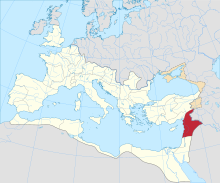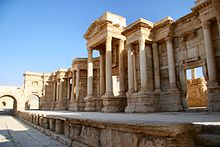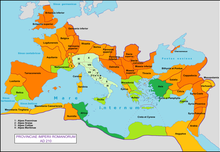
The 110s was a decade that ran from January 1, AD 110, to December 31, AD 119.
Year 115 (CXV) was a common year starting on Monday of the Julian calendar. In the Roman Empire, it was known as the Year of the Consulship of Messalla and Vergilianus. The denomination 115 for this year has been used since the early medieval period, when the Anno Domini calendar era became the prevalent method in Europe for naming years.
Abilene or simply Abila was a plain, a district in Coele-Syria, of which the chief town was Abila Lysaniou. The limits of this region are nowhere exactly defined, but it seems to have included the eastern slopes of the Anti-Lebanon range, and to have extended south and southeast of Damascus as far as the borders of Galilaea, Batanaea, and Trachonitis. According to Flavius Josephus, Abilene was a separate Iturean kingdom until 37 AD.

Legio III Cyrenaica, was a legion of the Imperial Roman army. The legion had its origins among the forces of Mark Antony during the civil wars of late first century BC. In the Imperial period it was stationed in Egypt, where it played a key role in campaigns against the Nubians and Jews. In the first century AD, it was usually located in Arabia Petraea. There are still records of the legion in Syria at the beginning of the 5th century. The legion symbol is unknown.

The Roman provinces were the administrative regions of Ancient Rome outside Roman Italy that were controlled by the Romans under the Roman Republic and later the Roman Empire. Each province was ruled by a Roman appointed as governor.

Julia Maesa was a member of the Severan dynasty of the Roman Empire who was the grandmother of emperors Elagabalus and Severus Alexander, elder sister of empress Julia Domna, and mother of Julia Soaemias and Julia Mamaea. She wielded influence during the reigns of her grandsons as Augusta of the Empire from 218 to her death, especially on their elevation to emperors.

The First Jewish–Roman War, sometimes called the Great Jewish Revolt, or The Jewish War, was the first of three major rebellions by the Jews against the Roman Empire fought in Roman-controlled Judea, resulting in the destruction of Jewish towns, the displacement of its people and the appropriation of land for Roman military use, as well as the destruction of the Jewish Temple and polity.

Syria Palaestina, or Roman Palestine, was a Roman province in the Palestine region between the early 2nd and late 4th centuries AD. The provincial capital was Caesarea Maritima.

The Jewish–Roman wars were a series of large-scale revolts by the Jews of Judaea and the Eastern Mediterranean against the Roman Empire between 66 and 135 CE. The First Jewish–Roman War and the Bar Kokhba revolt were nationalist rebellions, striving to restore an independent Judean state, while the Kitos War was more of an ethno-religious conflict, mostly fought outside the province of Judaea. As a result, there is variation in the use of the term "Jewish-Roman wars." Some sources exclusively apply it to the First Jewish-Roman War and the Bar Kokhba revolt, while others include the Kitos War as well.

Judaea was a Roman province from 6 to 132 CE, which incorporated the Levantine regions of Judea, Samaria and Idumea, extending over parts of the former regions of the Hasmonean and Herodian kingdoms of Judea. The name Judaea was derived from the Iron Age Kingdom of Judah.

Coele-Syria, alternatively Coelo-Syria or Coelosyria, was a region of Syria in classical antiquity. The term originally referred to the "hollow" Beqaa Valley between the Lebanon and the Anti-Lebanon mountain ranges, but sometimes it was applied to a broader area of the region of Syria. The area is now part of the modern-day Syria and Lebanon.

The Battle of Antioch was fought between the Roman army of the Emperor Macrinus and his rival Elagabalus, whose troops were commanded by General Gannys, probably a short distance from Antioch. Gannys' victory over Macrinus led to the downfall of the emperor and his replacement by Elagabalus.

The Herodian tetrarchy was a regional division of a client state of Rome, formed following the death of Herod the Great in 4 BCE. The latter's client kingdom was divided between his sister Salome I and his sons Herod Archelaus, Herod Antipas, and Philip. Upon the deposition of Herod Archelaus in 6 CE, his territories were transformed into a Roman province. With the death of Salome I in 10 CE, her domain was also incorporated into a province.

The Battle of Beth Horon was a military engagement fought in 66 CE between the Roman army and Jewish rebels in the early phase of the First Jewish–Roman War. During the event, the Syrian Legion Legio XII Fulminata with auxiliary support headed by Legate of Syria Cestius Gallus was ambushed by a large force of Judean rebel infantry at the passage of Beth Horon, on their retreat from Jerusalem towards the coastal plain. The rebel Judean forces headed by Simon Bar Giora, Eleazar ben Simon and other rebel generals succeeded in inflicting a humiliating defeat, killing some 6,000 Roman troops and capturing the Legion's aquila, with much of the Roman Army fleeing in disarray from the battle field. The defeat of the Roman Army had major implications in prolonging the rebellion, leading to the short-lived Judean self-governorship in Judea and Galilee.
Lucius Julius Gainius Fabius Agrippa, also known as Lucius Julius Agrippa, was a considerably wealthy man who descended from royalty. He lived in the second half of the 1st century and early part of the 2nd century AD in the Roman Empire.
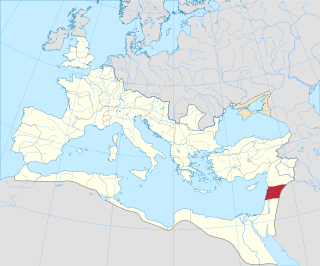
Phoenice was a province of the Roman Empire, encompassing the historical region of Phoenicia. It was officially created in 194 AD and after c. 394, Phoenice Syria was divided into Phoenice proper or Phoenice Paralia, and Phoenice Libanensis, a division that persisted until the region was conquered by the Muslim Arabs in the 630s.

Publius Sulpicius Quirinius, also translated as Cyrenius, was a Roman aristocrat. After the banishment of the ethnarch Herod Archelaus from the tetrarchy of Judea in AD 6, Quirinius was appointed legate governor of Syria, to which the province of Judaea had been added for the purpose of a census.

Coele Syria was a Roman province which Septimius Severus created with Syria Phoenice in 198 by dividing the province of Syria. Its metropolis was Antioch.
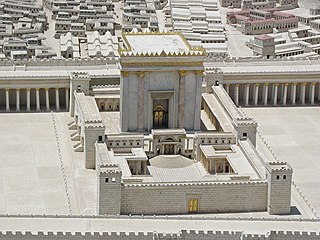
The Second Temple period in Judaism began with the end of the Babylonian captivity and the Persian conquest of the Near East in 539 BCE. The Second Temple was then built, and finished around 516 BCE. The conquests of Macedonia under Alexander the Great in 332 BCE saw Judea and the Near East placed under Greek influence during the Hellenistic period; Hellenistic Judaism blended both Greek and Jewish traditions. The Maccabean Revolt of 167–142 BCE was fight a first for Judean autonomy against a suppression of traditional Judaism, and later acquired outright independence under the rule of the Hasmonean family in an independent Hasmonean kingdom. The Hasmoneans would rule until 63 BCE, when they were reduced to client king status as Roman puppets; that too would end in 37 BCE, with King Herod the Great taking control, leading to the Herodian dynasty. Herod's death would lead to both the Herodian Tetrarchy where smaller regions ruled by members of his family, as well as direct Roman control by the governors of Roman Judea. The period would come to an end with the First Jewish–Roman War of 66–73 CE. Jerusalem was conquered in 70 CE, and the Second Temple was destroyed.
